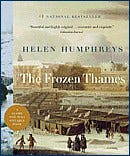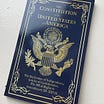The River Thames in London has frozen solid forty times in the last millennium. Humphreys commemorates each icy episode with a brief vignette in The Frozen Thames, a volume gilded with lyrical prose and adorned with historical art prints. From high to low, rich to poor, the people of London are frozen in time along with their river in each of Humphreys’s impressionistic sketches.
Queen Matilda, under siege in 1142, “saw the river freeze” from her castle window, “the moment when the water took hold of itself and wouldn’t let go.” A man living on London Bridge in 1282 muses, “Ice is stronger than water. Ice is made from water, but it does not seem to remember water.” He remembers that during the thaw from the 1269 freeze, sections of the bridge collapsed into the river.
Another thaw after another freeze in 1740 “goes just as badly as the freeze.... It is as though the people of London need reminding that the river is a wild thing and this cannot be forgotten because, if it is, the Thames will simply arch its back and throw anything off that tries to tame it.”
If not a true historical novel, The Frozen Thames is a true accounting of the river in its frozen persona from a millennium-long segment of its life. The people on its banks or attending a Frost Fair on the river itself come and go in their allotted moments. We recognize some, many are long forgotten, but each claims our attention for the instant Humphreys shines her poetic spotlight on them.
Sated with crystalline images, yet ravenous for more, I came away curious about each occurrence, wanting to find fictionalized accounts of gravestone engravers in the eighteenth century and the inception of English football in the more distant past. I’d love to read a novel about a Frost Fair in medieval days and an ice feast for the poor served up on the frozen river by Grey Friars monks. (2007, 181 pp.)






I’d nearly forgotten this magical book! I now know what to get for Christmas for a history/book-loving friend!